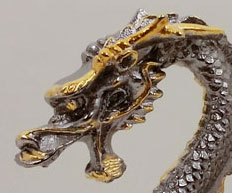
Eastern Mysticism meets Western Alchemy
Dragons possess transformative qualities, the ability to shed scales and become more powerful and dynamic. Restoring dragons allows us the opportunity to harness that energy for our own purposes and further perpetuate the belief that dragons are real.
One of the most iconic depictions in dragon mythology is that of the dragon holding a pearl. Originating from Chinese mythology, the actual meaning of the pearl is a topic of great debate among dragon lovers. In early Chinese mythology stories, dragons controlled water. The moon was symbolic of water, and therefore an desired object for a dragon.
The image can also be seen on the coat of arms of Chinese emperors as early as the Han Dynasty. In this case, the dragon and the pearl represent two things needed to successfully rule: authority and wisdom.
With the introduction of Buddhism in to traditional Chinese culture during the Tang Dynasty, the pearl can be seen bursting in flame. While some say the flames depicts the sun, others suggest this represents the ‘divine pearl’ of Buddhist faith, the jewel that grants all desires. One story speaks of dragons “in pursuit of effluent jewels and orbs that appear to be whirling in space, and that were supposed to be of magic efficiency, granting every wish.” This would explain why the dragon’s expression is so intense! Defining the precise meaning of the pearl defeats the purpose of why we enjoy dragon mythology. Meanings attributed to the pearl may change over time, but the fundamental desire to obtain does not. The pearl is truly in the eye and in the mind of the beholder.

Journey to the east, in search of dragons
These dragons were found lying neglect in one of the narrow alleyways of the Dong Tai Antique Market in Shanghai. They are a bronze cast alloy with a patina to make them look “ancient”; as if they had just been dug out of the ground. In our view, a patina on a dragon’s body undermines what makes dragons so unique. Image plucking the plumage off a peacock, would it be as vibrant?. Dragons are the same in this way. Holding these dragons, one could imagine that they too understood that their full splendor was not expressed in the way that tradition intends.

Since we are by trade western alchemists (electro-platers) focused on the transformation of liquid gold into solid gold we simply could not let these poor dragons remain tarnished and neglected. So the ugly dark patina was completely but gently removed. Next the head, pearl, claws and top ridges of its scales were polished to a mirror finish.The rest of the dragon was deliberately left a satin bead blast to provide contrast and depth. Since the mythology stories vary, we thought it was appropriate to electroplate these dragons in four different colors: 18kt Medici gold, rhodium, platinum and ruthenium. The polished areas were further accentuated with a selective plating of gold or rhodium where appropriate. These combinations provided the best solutions for restoring the regal and splendid appearance of the dragons. These surface contours are greatly enhanced using modern electroplating methods to amplify every detail.
In our view what makes these dragons so special is their inherently beautiful presence, their coiled power, and the guardians of good fortune.
Ah dragons, whether it be guarding riches or obtaining wisdom they are truly ancient and timeless symbols of desire and beauty. Find your dragon and send him to us!

REFERENCES
Welch, Patricia Bjaaland. Chinese Art: A guide to motif and visual imagery. Tuttle Publishing, 2008.
Bates, Roy. All About Chinese Dragons. China History Press, 2007.
Williams, Charles Alfred Speed Williams. Chinese Symbolism and Art Motifs: A Comprehensive Handbook on Symbolism in Chinese Art Through the Ages. Tuttle Publishing, Second Edition, 2006.
Ingersoll, Ernest. Dragons and Dragon Lore. Payson & Clarke, 1928.
Metal Arts Specialties
+1 (248) 821-3450
Email
8AM–6PM EST


